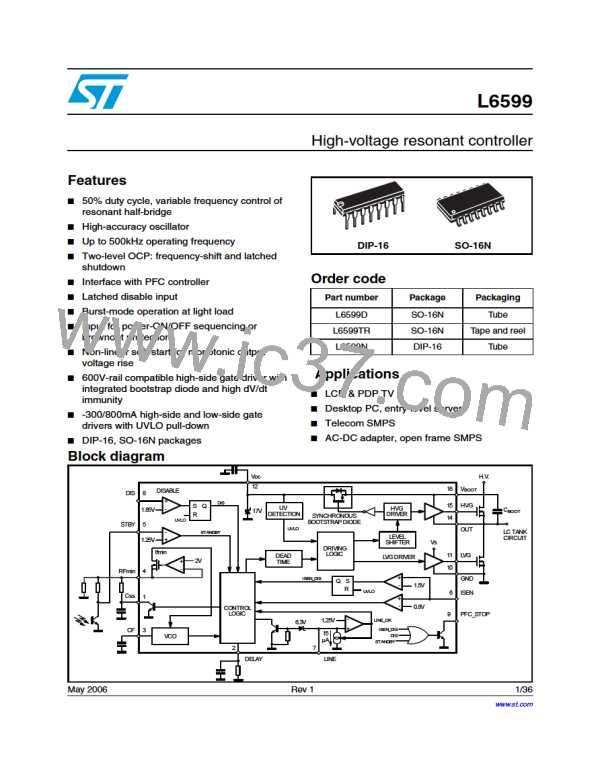L6599
Application information
The circuit shown in Figure 30 can be operated in two different ways. If the resistor R in
A
series to C is small (not above some hundred Ω, just to limit current spiking) the circuit
A
operates like a capacitive current divider; C will be typically selected equal to C /100 or
A
R
less and will be a low-loss type, the sense resistor R will be selected as:
B
Cr
1 + -------
CA
0.8π
⎛
⎝
⎞
⎠
--------------
=
RB
ICrpkx
and C will be such that R ·C is in the range of 10 /f
.
B
B
B
min
If the resistor R in series to C is not small (in this case it will be typically selected in the ten
A
A
kΩ), the circuit operates like a divider of the ripple voltage across the resonant capacitor Cr,
which, in turn, is related to its current through the reactance of Cr. Again, C will be typically
A
selected equal to C /100 or less, this time not necessarily a low-loss type, while R
R
B
(provided it is << R ) according to:
A
RA2 + XC2
0.8π
-------------- ---------------------------
A
RB
=
⋅
ICrpkx
X
Cr
where the reactance of C (X ) and C (X ) should be calculated at the frequency where
A
CA
R
Cr
I
= I
. Again, C will be such that R ·C is in the range of 10 /f
.
Crpk
Crpkx
B
B
B
min
Whichever circuit one is going to use, the calculated values of R or R should be
S
B
considered just a first cut value that needs to be adjusted after experimental verification.
OCP is effective in limiting primary-to-secondary energy flow in case of an overload or an
output short circuit, but the output current through the secondary winding and rectifiers
under these conditions might be so high to endanger converter's safety if continuously
flowing. To prevent any damage during these conditions it is customary to force converter's
intermittent operation, in order to bring the average output current to values such that the
thermal stress for the transformer and the rectifiers can be easily handled.
With the L6599 the designer can program externally the maximum time T that the
SH
converter is allowed to run overloaded or under short circuit conditions. Overloads or short
circuits lasting less than T will not cause any other action, hence providing the system
SH
with immunity to short duration phenomena. If, instead, T is exceeded an overload
SH
protection (OLP) procedure is activated that shuts down the device and, in case of
continuous overload/short circuit, results in continuous intermittent operation with a user-
defined duty cycle.
25/36

 STMICROELECTRONICS [ ST ]
STMICROELECTRONICS [ ST ]